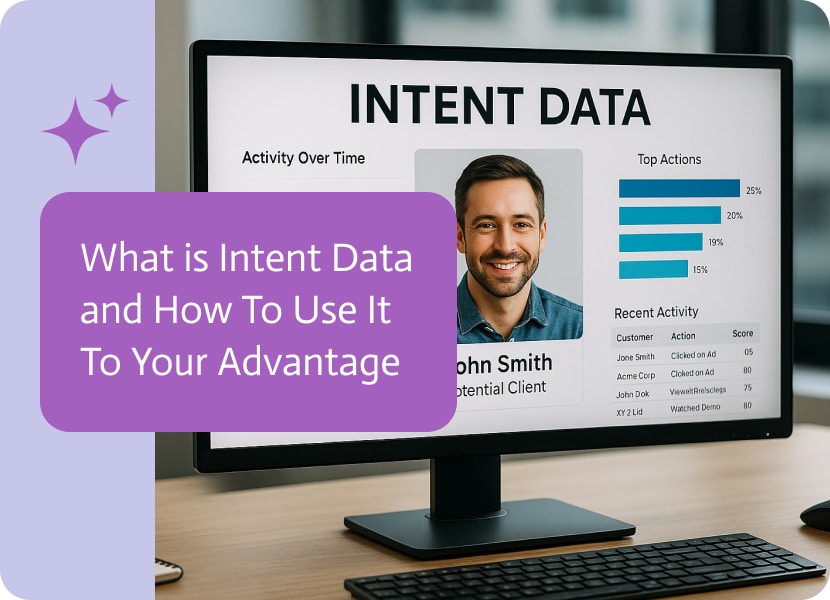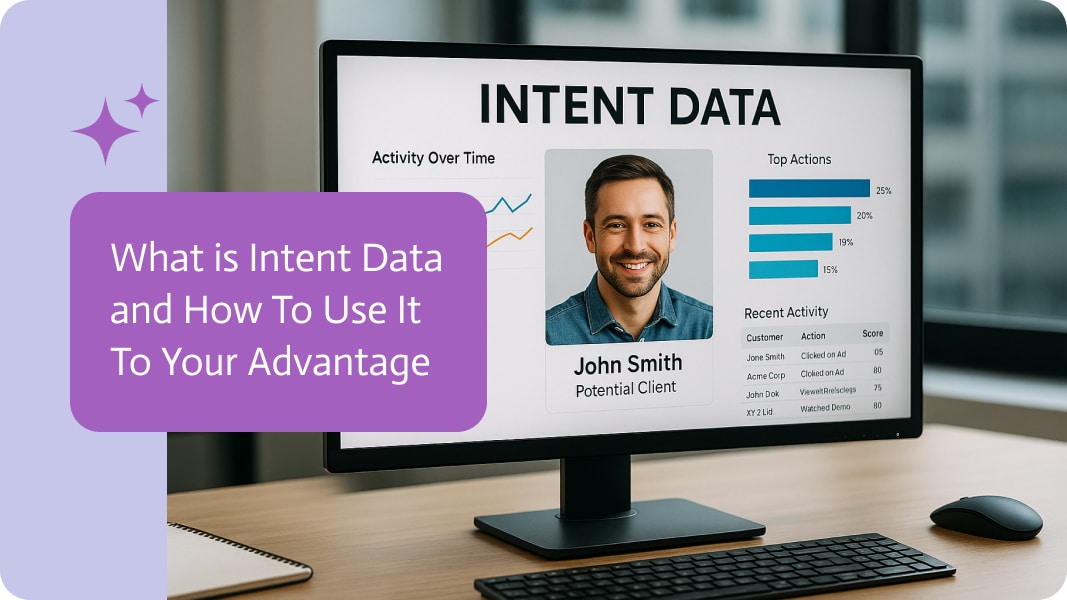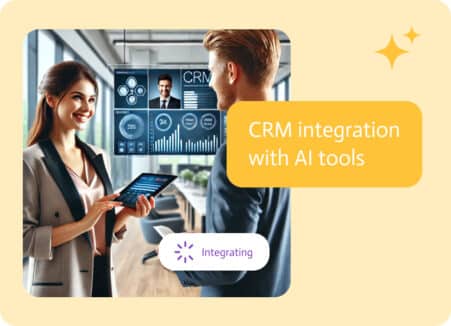

What Is Intent Data & How To Use It To Your Advantage
Intent data can be compared to intercepting a conversation on the internet “legally”, of course. It is the visible evidence searchers leave behind when exploring a subject, analyzing options, or making a justification for a planned purchase that no one has been told about, even your sales team. Their actions reveal the crucial information, regardless of what they might say. Additionally, actions typically speak louder than words in both business and life.
What if I told you that your sales team could start a pitch just as a customer was considering updating their cybersecurity software? Not when they have already chosen a competitor. Not when they have ignored your previous email marketing attempts. But when they are still checking Google search results for “best endpoint protection tools” at 11:47 PM while having coffee.
That is the magical realm of intent data, the not-so-enchanted prospecting strategy of tracking digital footprints to determine interests prior to gaining interactive feedback.
What is Intent Data?
Automatically capturing intent data is an intuitive process that does not require the use of forms, emails, or surveys because it tracks actions taken during web browsing, such as search engine queries, site visits, and reviews. This browsing session, which might seem idle to a passerby, is analogous to someone gazing through the window of a car dealership on a Sunday. While they may not be engaging with you directly, their thoughts are undoubtedly oriented towards a vehicle.
How about considering a mid-level IT manager who spends an afternoon reading “How to Prepare for a Cloud Migration,” “Top 5 AWS Alternatives,” “Noca AI vs AWS Pricing Breakdown,” and “Best Cloud Migration Tools for 2025.” Also, let’s include the downloading of a checklist titled “10 Steps to a Seamless Cloud Move.”
In the example, they still haven’t clicked “Schedule a Demo” on anyone’s site. Not yet, at least. They offer no clear intent signals, but rest assured, this isn’t mindless surfing either. That type of browsing showcases clear interest. It indicates that: “There is a problem, and active work is being done towards exploring various solutions and options.”
That is precisely the behavior intent data focuses on — the silent purchasing journey taking place behind closed tabs. It uncovers the digital marks people leave behind when waiting for the right moment to make a decision.
Now, combining behavior from thousands of companies and millions of webpages paints a clear picture of what is being monitored on the markets, which companies have purchasing intentions, and how long they spent exploring options.
In contrast to surveys or customer relationship management (CRM) notes, intent data does not depend on an individual’s recollection of events and their willingness to disclose the information. Intent data is behavioral evidence. It’s what people are doing, which is frequently more truthful than what they would express during a sales call.
The Three Alternatives of Intent Data
Not all intent data is created equal. Some is home-cooked, some is imported, and some is… well, borrowed.
1. First-Party Intent Data: The Stuff You Own
This is your turf. Data collected from your own website, emails, product dashboard, content downloads, the works. If someone is lurking on your pricing page for 7 minutes at 2AM, that’s a blinking neon sign of interest.
Examples:
- Blog posts read
- Ebooks downloaded
- Features explored in a product trial
- Webinar signups
Best part: It’s accurate and free.
Downside: You only get it after people find you.
2. Third-Party Intent Data: The Outsider Intel
Information about third-party intent is collected from a variety of online sources, such as forums, news websites, social media, and review sites. Vendors use cookies, natural language processing, and a little magic to determine which companies are researching specific topics.
Examples:
- Multiple employees at a company googling “ransomware prevention”
- Visits to competitor comparison sites
- Activity on G2, Reddit, or industry blogs
Best part: You see interest before they touch your site.
Downside: It’s less precise, and you’ll likely need to pay a data vendor (Bombora, 6sense, Demandbase, etc.).
3. Second-Party Intent Data: The Handshake Agreement
This is someone else’s first-party data that you get access to via a partnership. Think of it as data with a passport. Maybe a media site shares behavioral insights from its audience with a B2B platform, or two SaaS platforms agree to share anonymized usage data.
Best part: It can be super-relevant.
Downside: It requires trust and paperwork (and probably lawyers).
What Can You Really Learn From Intent Data?
In essence, intent data provides answers to the following four questions: What interests people? Anything they’re researching, including subjects, tools, and services.
- What level of interest is there?
- Is this an in-depth look or just a quick glance?
- Where are they in their decision-making process?
- Are they just exploring, actively comparing options, or ready to buy?
Let’s say a company is suddenly very active in searching for “data breach response plans,” downloading checklists, and clicking ads from cybersecurity vendors. That’s a buying signal.
Now compare that to someone who casually reads a blog about “types of cyber threats.” Probably a curious intern, not your next customer.
How Smart Companies Use Intent Data
Used right, intent data isn’t just another expensive line in your MarTech spreadsheet or some dusty tab in your CRM. It’s the compass that helps you steer your sales, marketing, and product teams toward people who actually care, instead of guessing and hoping.
Here’s how savvy teams put it to work:
Sales: Get In Before the Competition Does
Why wait around for someone to fill out a contact form (which they may never do) when you can catch them right as they start seriously shopping? Intent data lets sales reps ditch the cold calls and instead reach out to people already showing signs of interest, even if they haven’t touched your site yet.
These are the folks comparing products, researching solutions, and poking around on forums. They’re warm, even if they haven’t introduced themselves yet.
Smart move: Combine intent signals with firmographic data (like company size, industry, revenue, region, and tech stack) to prioritize the leads that actually fit your ideal customer profile. No more chasing tire-kickers or startups with $0 in budget.
Marketing: Stop Shouting, Start Whispering
Ever spent five grand on ads just to get ten clicks and one confused lead asking if your software works on flip phones? That’s what happens when you talk to everyone and no one at the same time.
Intent data flips that. It lets you zero in on the people already leaning in so you can meet them with the right message at the right moment. If a target account is knee-deep in content about “zero trust security,” don’t hit them with your generic awareness ebook. Send them a sharp, punchy case study about how your product helped a similar company lock down their network.
Bonus move: Dynamically personalize landing pages and email campaigns based on what you know they’re interested in. It’s creepy how effective it is, but not actually creepy, because it’s useful.
Also, your ad budget? It goes way further when you’re not targeting people who couldn’t care less.
Product Teams: Read the Market’s Mind
For product managers and R&D folks, intent data is like market research without the awkward focus groups. If you’re seeing a rising wave of intent around topics like “AI-powered analytics” or “voice-enabled dashboards,” and you’re already building something in that zone, congrats, you’ve got your finger on the pulse.
On the flip side, if you’re investing six months into a feature nobody’s showing interest in (crickets on the topic across the board), maybe it’s time to reconsider. Intent data gives you a kind of sixth sense about what customers will want, not just what they’ve said in a roadmap session six months ago. It’s not fortune-telling. It’s evidence-based foresight.
Intent Doesn’t Mean Contract
Just because someone’s researching your industry doesn’t mean they’re ready to throw money at you. Intent data is context, not clairvoyance.
People browse for all sorts of reasons:
- A student writing a thesis
- A competitor spying
- Someone curious but broke
That’s why intent data works best when combined with other signals:
- CRM insights
- Website behavior
- Email engagement
- Historical buying data
Real-World Scenario
Let’s say you’re a company that sells compliance software.
You notice a mid-size healthcare company has been surging in searches related to “HIPAA audit checklist,” “compliance automation,” and “how to pass a health data security assessment.”
They haven’t visited your site yet, but you’ve got their domain, and you know their industry. Your sales team reaches out with a timely message:
“We noticed many healthcare orgs are prepping for mid-year audits. Here’s a quick checklist our clients use to breeze through theirs, thought it might be helpful.”
This is a brilliant way to get your foot in the door and will prove to be an indispensable tool in your arsenal if you want your business to succeed in a high-octane world.
Popular Tools That Help You Tap Intent Gold
Here’s who’s making noise in the intent data world:
- Bombora: One of the biggest names in B2B intent data, with a massive co-op of sources.
- 6sense: Combines AI and intent signals to predict buying behavior.
- Demandbase: Great for ABM (account-based marketing) with strong intent signals.
- ZoomInfo: Merges contact info with intent insights for sales teams.
Each tool has its quirks, so demo a few and see what fits your use case.
Final Thought: Be Useful, Not Pushy
Intent data isn’t a license to carpet-bomb inboxes with generic pitches or to stalk every company that googles something remotely related to your industry. It’s not about being louder, it’s about being sharper, smarter, and more relevant.
Used with finesse, intent data turns your outreach from intrusive to intuitive, like showing up to a party not just uninvited, but perfectly timed, holding a bottle of their favorite wine they didn’t even know they were craving. That’s not just good marketing. That’s magic.
But here’s the kicker: if you’re still treating lead gen like a game of darts in the dark, just lobbing messages and hoping something sticks, you’re not just wasting time. You’re leaving opportunities on the table. Worse, you’re leaving them open for your competitors to scoop up while you’re still refreshing your email campaign metrics.
Intent data gives you the advantage of seeing the signals before the noise starts. It lets you follow the digital breadcrumb trail straight to buyers who are already leaning in your direction before they hit your site, before they download your white paper, and before they get on anyone else’s radar.
So, stop guessing. Start listening. Whether you’re chasing down a red-hot lead, crafting a targeted campaign, or fine-tuning your roadmap, intent data isn’t just helpful — it’s the edge your team needs to stop reacting and start anticipating.


